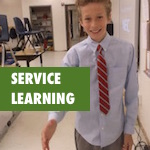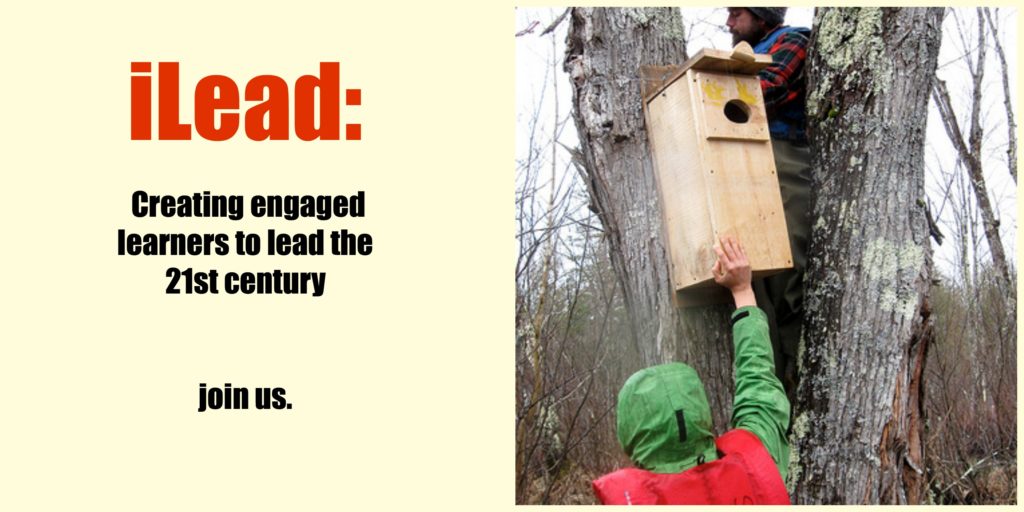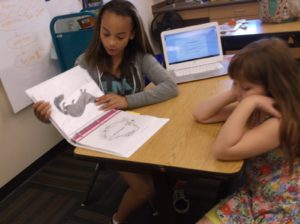Personalization for school-based service learning
 Looking for a way to harness students’ energy while giving them meaningful work that appeals to their personal interests? One model for service learning I’ve used is iLead: a “job-based” program that channels student interest into meaningful positions around the school.
Looking for a way to harness students’ energy while giving them meaningful work that appeals to their personal interests? One model for service learning I’ve used is iLead: a “job-based” program that channels student interest into meaningful positions around the school.
School community improves, students learn responsibility in a way that engages with their interests, everybody wins.
Here’s how it works.
What’s service learning?
Service learning is a method of teaching/learning that challenges students to identify, research, propose, and implement solutions to real needs in their school community as part of their curriculum. It is also a learning tool to empower students to solve problems in their own communities, or even globally.
Explore the differences between community service, project based learning, and service learning here.
What is iLead?

iLead is a model for service learning where students develop leadership skills, self-efficacy, independence, community, and belonging along with their own interests.
Essentially, in iLead:
- Students analyze their own interests and passions, and what issues, challenges, or needs exist at the school.
- A group of school staff presents leadership opportunities — i.e. jobs — that students can apply for at the school.
- The students write cover letters and resumes and apply for a school-wide leadership position.
- Once each student has their school job, they meet with mentors regularly for feedback and support, troubleshoot with their teachers, and do frequent reflections.
- During the tenure of the job, students create a digital or IRL portfolio of their learning, and share it with the community during an exhibition of learning.
Creating the iLead infrastructure
How to begin? With students of course!
Students complete interest inventories and learning profiles at the beginning of the year. They explore who they are and share that with the class: in their PLPs, in morning meeting circle, and via written reflections. The teachers take note of these interests as they learn more about their students.
But teachers are also vital to the success of iLead and have several important functions.
Set up a climate of respect and empowerment
First, teachers explain to the students how middle school students are the leaders of the school; these students are perfectly poised to become more independent and take on more responsibility. Teachers also explain to the students that they have their instructors’ full trust and faith. Work with students to create a strong, supportive community and norms.
Identify the needs of the school and create jobs that address them
Second, teachers meet with the school staff. They ask, “What are some needs in this school that can also serve as true leadership and service opportunities for our students? And what are some jobs that middle school students can take on to serve those needs?”
Because every school is unique, the needs of each school will be different, but here are some job ideas that we did at Rumney Memorial as part of what would become the iLead program:
- Primary PE Assistant
- Reading Hero
- Videographer
- Photographer
- School Public Relations Team
- Yearbook Creators
- Sports Reporters
- Media Ninjas
- Chef Assistant
- School Nurse Assistant
- Spanish Assistant
- Music Assistant
- Sign Language Assistant
- Guidance Lesson Assistant
- Math Games Coordinator
- Trail Builders
- Global Education Advocates
- Earth Heros
Start building a job board
Next up, teachers build a job board. This classic Help Wanted-style bulletin board will get students excited as the postings begin to roll in.
Have students write cover letters and resumés

A class lesson is necessary explain to students how to write cover letters for 2-3 of their desired jobs, and resumés appropriate for their developmental level. As the lesson unfolds, each teacher explains the purpose of these forms of writing, and perhaps share their own CV or a mock cover letter they themselves have written. In this way teachers build social capital and a narrative of opportunity for the students.
They should also research good interview skills and then practice with each other.
Set up interviews for the school jobs
For each job created at the school, teachers and administrative staff agree on a mentor, who will take on the role of “boss” for the job. Once every job has a mentor, mentors schedule five-minute interviews with students. They can ask questions like:
- Why do you want this job?
- What do you think you will learn?
- What do you think will be challenging?
- What will you bring to this job that will help others and your school?
After all the interviews have been completed, the mentors and teachers confer and decide on a job for each student that aligns with his or her interests.
Send out official job offer letters
Students then receive very official letters of job offers (on school letter head, signed by the principal), and begin their weekly assignments with support and guidance from the teacher.
A note about scheduling
Next, plan with mentors and students when the weekly sessions will take place (often 30-40 minute blocks). It helps to set up a calendar that you can share with all of the students. It is important to help students learn how to remember this weekly commitment and that it is their responsibility (with some support) to do this. Students will miss some class time, and will have to make up the work or time. Schedule iLead weekly sessions at times that make sense for each individual student. Sometimes students meet for longer blocks with mentors every two weeks or once a month. This can be discussed with students and mentors for what works best for everyone. Flexibility and openness on the part of teachers, mentors, and students is important for making this all work!
iLead is underway
Each week, students reflect on their growth and learning in several ways. They can pick from prompts and meet with the teacher. During the year, students gather artifacts and reflections for their portfolios.
At Rumney Memorial, jobs usually ran from October-May. During this time, they build their portfolios, reflect, and get ready to share with their community. You can use this scale to assess the whole project experience based on Transferable Skills. Other scales and rubric can be used for assessment during the process as well. School board members, mentors, parents, and the whole school are invited to this exciting exhibition of learning.
What do students think of iLead?
Here’s a smattering of responses from sixth graders I’ve worked with:
- “[It] made me want to come to school more. I knew that the first and second graders depended on me to help them play safely and include others at recess.”
- I watched this student’s attendance increase.
- “[It] is important because we have the opportunity to try new things and learn new things, but I think the big idea is helping people. It makes me feel wonderful knowing that because of me a student have new experiences. It felt amazing to be able to help people.”
- I watched this student gain confidence.
- “Being able to teach youngers in one of my favorite subjects, makes me feel amazing.”
- I watched this students’ sense of belonging grow and she became an important member of the school community.
The culture of the school changed, too. Schools depend on the leadership of its students, and with iLead, students blossomed in that trust and independence.
Sure, there were mistakes, missed jobs, and missteps. But this is the learning: students learned to be on time, to do what they said they would do, and to provide service to others. And by doing so they improved the school, from the inside out. Some students found their life long passions in this project– and went on to study the topics they began in iLead.
Would iLead be a good fit for your students? Have you done something similar in your school?




One Reply to “iLead: a model for service learning and leadership”
Comments are closed.